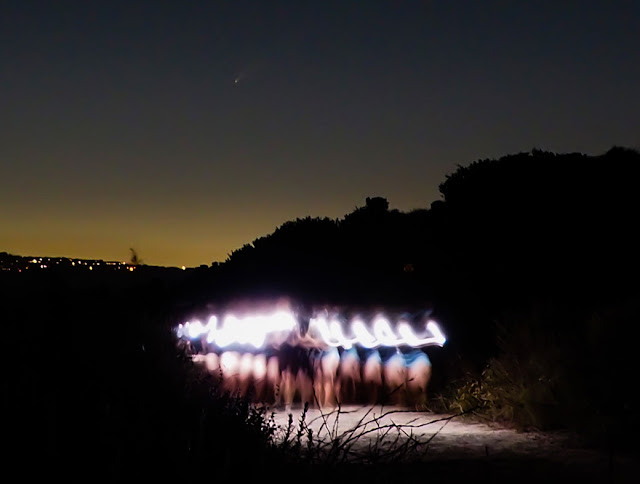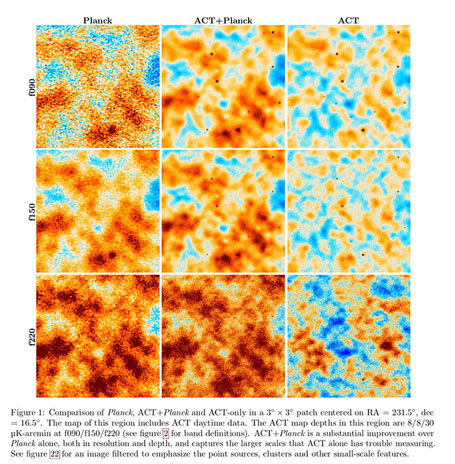Well, this week has been mostly preoccupied with finding comet NEOWISE in the evening sky. After getting some success there we will move on to some other OCA images and review some other astronomy news and comment on a UFO book.
After capturing the comet early in the morning we wanted to try in the evening because then you are not squeezed so tightly between the rising comet and the rising sun. So, after finding a nearby site from which to possibly observe the comet, more about the details of finding a site later, we set up the flimsy tripod at a little after 9:00 pm, Thursday evening. There were too many city lights for me to see the dim comet, so, I had to rely on my assumptions of where to point the camera. Then I just panned across the rooftops to find the comet. Hooray, there it is!
 |
| Comet NEOWISE at 9:16 pm, DSLR, 100 mm, 8 second exposure (Source: Palmia Observatory) |
Once the comet was located, then I adjusted the telephoto lens from 100 mm focal length to 300 mm. I had to refocus and had to move the camera away and point at Jupiter which was high in the sky in the opposite direction. Then back to the location of the comet took just a few more minutes of panning near the recent observation. Hooray, here it finally is again!
 | |
|
In this iPhone photo of the camera setup, with the comet visible in the camera LiveView screen, you can see there are a lot of nearby house lights and of course the sky had a lot of city lights pollution too.
 | |
|
So, how do you know where to point your camera to capture the comet when you can't see the comet with your own naked eyeballs? Well, you ask Siri or whoever else is your electronic muse, of course! This screenshot from the iPhone app, GoSkyWatch, shows the predicted camera azimuth and altitude pointing angles for the comet at 9:10 pm. So all I did, and all you have to do also, is find and select a location where you can see low on the horizon, like about 10 degrees elevation, at an azimuth of about 321 degrees. So, all I did was do some scouting earlier in the day and found a good location where the house rooftops and trees were not in the way. I used the iPhone compass to get the azimuth and used the setting sun to estimate the lowest elevation just above the rooftops.
 |
| GoSkyWatch app screenshot shows comet NEOWISE sky location (Source: Palmia Observatory) |
So, that is how I did it. So go out and do it yourselves, but remember the comet is very dim and you won't see it with your eyeballs unless you are in dark skies. Other OCA members have been busy also out trying to capture the comet as well. Many folks report from dark sky sites and they get very impressive images. We also got an email from Science Nerd and Theatre Impresario, Scott, who was able to get this comet image from Laguna Beach area. Hmm, you can see some innocent bystanders in the foreground that are wandering around in this timed exposure. Anyway, yes, there the comet is, so thanks for that Scott!
 |
| Comet NEOWISE, and foreground motion, as seen in Laguna Beach, July 15 (Source: OCA Scott G.) |
Other Orange County Astronomers are busy capturing comets but in addition capturing some very dim objects that truly require a dark sky observing site and multiple long exposures. An example of that is this image of The Snake, also known as Barnard 72. This snake like image is a dark globular arrangement of dust that is located between us and the background Milky Way stars, so it just sort of blots out the background stars. B72 does not itself emit any light, but blocks out the light from background stars. Hmm, so does that me that we see the B72 or that we actually don't see the B72? Anyway this image is made up of 13 separate, 5-minute exposures. Great work and great skill, so thanks so much for that, OCA Dave! You can check out more of Dave's great work at his website: https://astrocamera.net/index.htm
 |
| Great view of the Snake (Barnard 72) (Source: OCA Dave K., https://astrocamera.net/) |
Ok, that is enough of the fun out looking at the night sky, let's take a look at some other astronomers who look at the microwave sky and review their latest findings. This article in Nature reports on the latest data analysis of combining CMB data from the Planck mission and CMB measurements made at the Atacama Cosmology Telescope (ACT) in Chile. Here you can see the ACT inside of its large cone structure that keeps stray land based radio signals from entering the telescope.
 |
| The Atacama Cosmology Telescope (Source: Nature) |
The paper referenced in the Nature article describes the analysis of 10 years of ACT data, from 2008 to 2018 and the combination of that analysis with data analysis from the Planck mission. One of the results of this study is a refined estimate of Hubble's constant. This separate independent measurement of Hubble's Constant supports the view that the Planck estimate is perhaps the better estimate than that made by the supernova measurements. But we will need to see. Anyway in the figure below you can (sort of) see how ACT data is used to augment the Planck data.
 |
| Combining Planck and ACT data improves Hubble estimate (S. Naess, et al, arXiV:2007.07290) |
One final figure from the original paper caught my eye. Check out the figure below which shows some of the current galaxies and objects that we see in optical and radio now and how those objects show up in the ACT microwave data. This figure was quite unusual because we are used to seeing the final processed image of the CMB thermal images and are struck by how uniform the temperatures are. Here we see the data without all of the corrections that go into making those temperature measurements. The data analysis is pretty much over my head, but feel free to knock yourself out with the original papers.
 |
| Combining Planck and ACT data improves Hubble estimate (S. Naess, et al, arXiV:2007.07290) |
Finally, after racking your brain on microwave data analysis, if you want to delve into some easy conversation about UFOs then check out this Science Salon interview with David Halperin, author of "Intimate Alien: The Hidden Story of the UFO." Halperin is a retired religious studies professor, who admits to being a committed UFOlogist from his earliest teenage years. I found Halperin very personable and engaging and brings an important view of how we ourselves try to find meaning in UFO encounters. The book is not a UFO debunking book, but instead looks at the different and common interpretations that witnesses bring to their interpretation of what the strange events they saw in the sky. If you are interested in this topic, check out the interview and buy the book if you are inclined. The video interview is at: https://www.skeptic.com/science-salon/david-halperin-intimate-alien-hidden-story-of-the-ufo/?mc_cid=143b8671f2&mc_eid=da50b448b5
 |
| David Halperin, "Intimate Alien: The Hidden Story of the UFO" (Source: Science Salon #124) |
Until next time, here from our burrow, stay safe, as we recover more of our freedom,
Resident Astronomer George
Be sure to check out over 400 other blog posts on similar topics
If you are interested in things astronomical or in astrophysics and cosmology
Check out this blog at www.palmiaobservatory.com

No comments:
Post a Comment